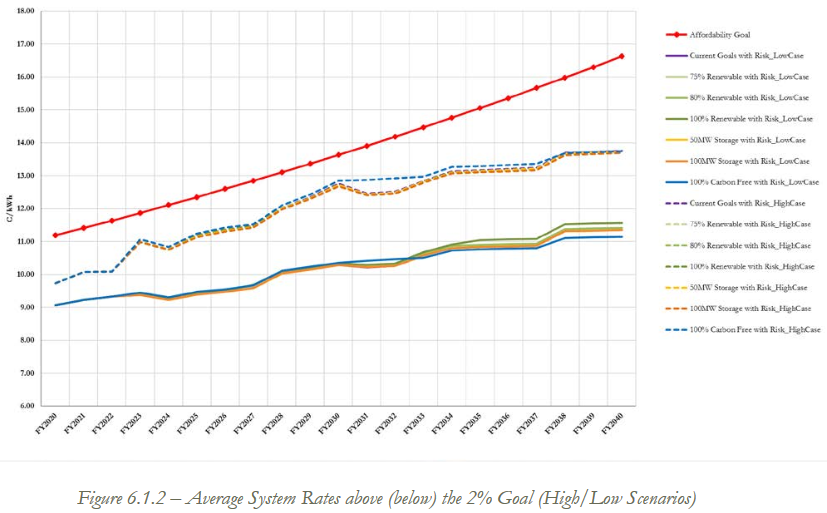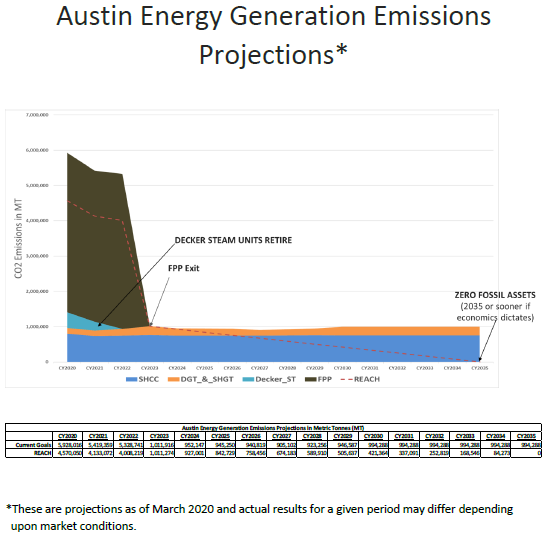Austin Energy Resource, Generation and Climate Protection Plan Update
Next Step: City Council
Austin is fortunate to have a publicly owned electric utility. Instead of answering to shareholders, the utility is beholden to the people of Austin and governed by the Austin City Council. This makes it possible for us and other advocates to push the utility to be an accountable, driving force in the transition to renewable energy.
One of our best tools for increasing renewable energy and energy efficiency goals, and setting retirement dates for the utility’s fossil fuel power plans, is the Austin Energy Resource, Generation and Climate Protection Plan. An update to that plan is now heading to the Austin City Council for consideration.
STUDIES AND PROCESS
A working group started meeting in September to advise on the update. The group received updates on Austin Energy’s current progress and past achievements, and various assumptions that go into modeling of future scenarios (current and projected prices for different energy sources and batteries, etc.) Austin Energy presented several studies that evaluated the affordability of:
- increasing renewable energy goals, shutting down all of the utility’s fossil fuel power plants by 2030 and increasing the use of energy storage,
- increasing local solar goals,
- increasing energy efficiency goals,
- options for expanding access to rooftop solar, and
- off-peak electric vehicle charging.
Encouragingly, these studies all showed that there is opportunity to do more to speed up the transition to clean energy, while maintaining affordability.
As shown in the graph below, Austin Energy could shut down all of its fossil fuel power plants by 2030 and replace that power production with renewable energy while staying within the established affordability goal of keeping rate increases to no more than an average of 2% per year.
Although replacing all of the utility’s fossil fuel power plants with renewable energy by 2030 was modeled to be affordable, Austin Energy staff are nervous about committing to a t transition on that timeline because they don’t know how much the energy storage (batteries) will cost. The price of lithium-ion batteries has fallen by about 80% over the past five years and utilities are starting to invest in batteries at an increasing rate, as an alternative to building new power plants. It seems quite likely that large scale batteries will be an affordable option for Texas utilities in the next few years, but Austin Energy, like most utilities, wants to be sure that something will be affordable before committing to it.
WHAT’S IN THE PLAN
So, the proposed plan commits the utility to shutting down its last natural gas power plants in 2035, not 2030. But, the utility will study the costs and timeline for making transmission infrastructure investments needed to shut down those plants. That study will examine the possibility of closing them in 2027 or 2030.
Importantly, the commitment for Austin Energy to stop burning coal by the end of 2022 remains in the plan. And two natural gas units at Decker Creek will be shut down in 2020 and 2021.
The proposed plan also includes a new element – artificially raising the price of power from the utility’s fossil fuel power plants to discourage their use. This price increase will have a similar effect as a local carbon tax, reducing emissions. Using the price adder should result immediately in the Fayette coal plant running less frequently. Given the state of the climate crisis, that’s important. The graph and table below show projected emissions from Austin Energy power plants with (dashed red line) and without the price adder.
The proposed plan also increases local solar goals – including goals for homes and businesses – and energy efficiency and demand response goals.
- LOCAL SOLAR GOAL: 300 megawatts (MW) by 2030, with 200 megawatts being customer-sited (solar located at homes and businesses)
- DEMAND REDUCTION GOAL: 1,200 MW, with 225 MW from demand response (using technology and other strategies to reduce usage during high usage periods) and the rest from energy efficiency (strategies that reduce overall energy use)
While we would prefer more initiatives to ensure equitable access to local solar, energy efficiency and demand response programs, there are some commitments in the proposed plan:
- Expand the Shared Solar billing solution that allows for solar to be used more effectively at multifamily properties.
- Provide moderate and limited-income customers preferential access to community solar programs.
- At least 25% of the customers served by energy efficiency, demand response, solar and green building programs should be limited-income customers (those at or below 200% of the federal poverty level).
- Austin Energy will work with the Austin Equity Office to contract with a third party to gather input from limited-income communities and communities of color, and others who cannot afford or access current programs. The purpose is to identify barriers and possible solutions to improve and expand programs.
ADDITIONAL RECOMMENDATIONS FROM COMMISSIONS
The Electric Utility Commission and the Resource Management Commission (two boards that advise the Austin City Council on Austin Energy matters) both recommended that Austin Energy work with the Austin Equity Office to ensure that the next update is conducted in a way that is equitable, includes communities of color and establishes open and transparent communications procedures. While this plan is a good step forward in several ways, the process for this update did not meet this standard.
It’s essential that equity, diversity and inclusion are fully integrated into future planning processes and that Austin Energy prioritize these principles as the utility evaluates its programs and how to serve customers. Reducing greenhouse gas emissions is critically important, but climate justice can only be achieved if we ensure that those who have often been left behind can benefit from the transition to clean renewable energy.
Because there are several pieces of information that Austin Energy will gather in the next couple of years (results from the transmission study; results from the equity meetings; changes in battery prices), the Resource Management Commission also recommended that the next update be scheduled for 2023. The plan has traditionally been updated every 2-3 years, but Austin Energy wants to move the schedule to every 5 years. The Commission was concerned that too much would change in that time and opportunities for improvement would be missed.
NEXT STEP – CITY COUNCIL
The proposed plan now heads to the Austin City Council for consideration. So, whether you think the plan is great as it is or would like to see it improved in some way, now is the time to share your views with Mayor Adler and the rest of the Austin City Council.

